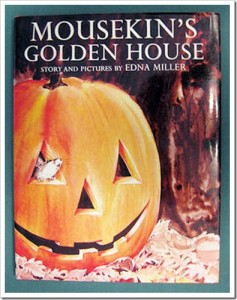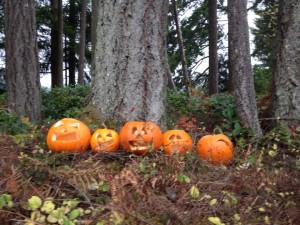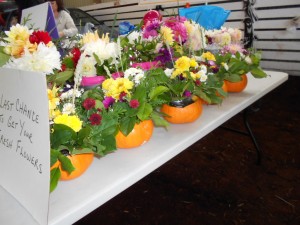Wondering what the kids can do with the pumpkin they carved now that Halloween is over? How about turning it into a house? No magic wand or witch spell needed. Just the magic of nature.
 Once Halloween is finished, kids can also put their jack-o-lantern outside in a corner of the yard or a wooded area. Sometimes, small animals like mice can use the hollowed gourd as a home. In the wonderfully illustrated story, Mousekin’s Golden House, by Edna Miller, a little mouse makes a den inside a jack-o-lantern after Halloween where he sleeps inside all snug and warm, protected while the fall wind and winter snow blow outside. The story also shows other animals looking for homes in the mud around the pond.
Once Halloween is finished, kids can also put their jack-o-lantern outside in a corner of the yard or a wooded area. Sometimes, small animals like mice can use the hollowed gourd as a home. In the wonderfully illustrated story, Mousekin’s Golden House, by Edna Miller, a little mouse makes a den inside a jack-o-lantern after Halloween where he sleeps inside all snug and warm, protected while the fall wind and winter snow blow outside. The story also shows other animals looking for homes in the mud around the pond.
 Even though a jack-o-lantern has a face or other design, it’s still a part of nature and nature has lots of ways to reuse and recycle. Pumpkins make good compost that will nourish a garden next spring for planting the seeds saved from them. A whole cycle from seed to pumpkin to seed.
Even though a jack-o-lantern has a face or other design, it’s still a part of nature and nature has lots of ways to reuse and recycle. Pumpkins make good compost that will nourish a garden next spring for planting the seeds saved from them. A whole cycle from seed to pumpkin to seed.
Nature and science need to be part of children’s ordinary experiences and not separated. They are not subjects that kids learn about at school, rather, they are part of daily life. Basic knowledge of science and nature will form the foundation for all kinds of learning. A connection to nature supports emotional and mental development in children,
 Thinking about what to do with the pumpkin, asking questions, and talking about possible solutions are also a great way for kids to use language. They practice problem-solving and may have some imaginative and creative suggestions of their own. You can also discuss other ideas with kids and get their reaction. Could a jack-o-lantern be used to grow flowers? What might happen to the dirt and the water? Could it be saved until next year? What might happen to it in the meantime?
Thinking about what to do with the pumpkin, asking questions, and talking about possible solutions are also a great way for kids to use language. They practice problem-solving and may have some imaginative and creative suggestions of their own. You can also discuss other ideas with kids and get their reaction. Could a jack-o-lantern be used to grow flowers? What might happen to the dirt and the water? Could it be saved until next year? What might happen to it in the meantime?
Halloween might be over, but the pumpkin still has some learning and fun to share. What do you do with the pumpkin at your house?
